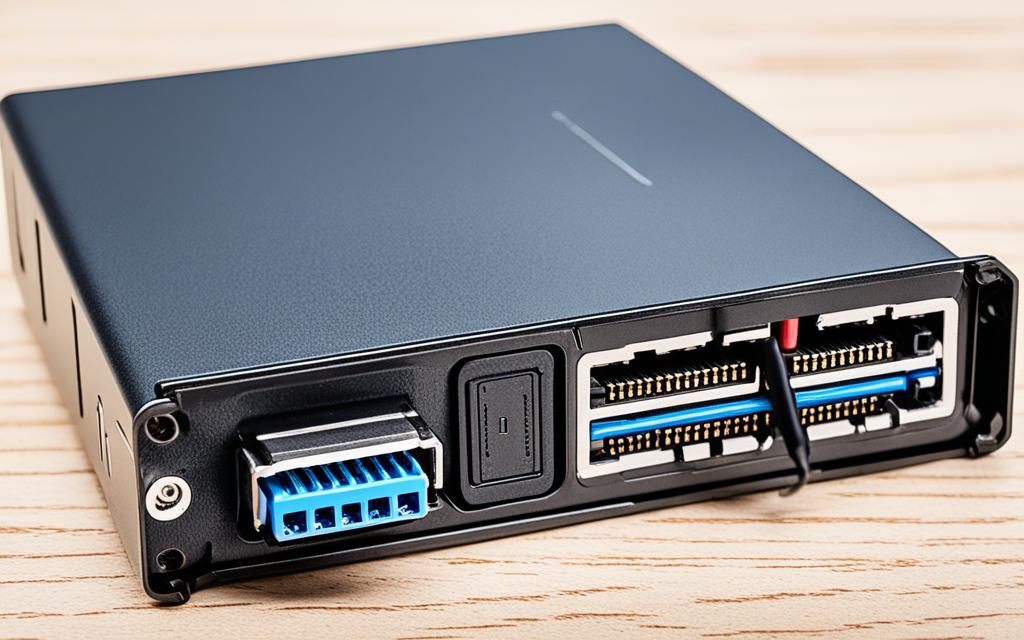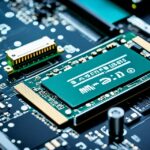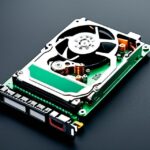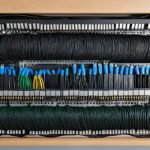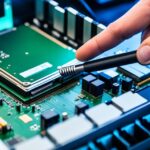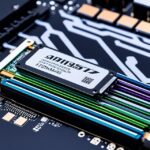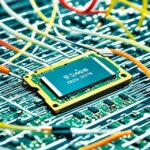Table of Contents
As we move forward in the tech world, adding a Solid State Drive (SSD) can really boost your computer’s speed and effectiveness. It’s vital to know the right cables needed for hooking up an SSD. This depends on the SSD type you go for. You need to understand the connections like SATA cables, M.2 interface, and NVMe SSDs for it to work right.
Being aware of what your system can handle ensures you’re ready to make the most of SSDs. They’re known for their reliability and speedy performance compared to older hard drives. This is because SSDs don’t have moving parts, so they’re less likely to break down1. With SSDs bringing speeds 10 times quicker than the old drives2, getting everything set up correctly means you’ll see incredible improvements right away.
Key Takeaways
- Understanding different SSD types is key to choosing the right cables.
- SATA cables are required for traditional SATA SSDs.
- NVMe SSDs connect directly to the motherboard, requiring no cables.
- Ensure your power cables are of good quality to protect your SSD from data loss.
- Be aware of compatibility issues that may arise with motherboard connections.
- SSD installations can significantly improve system performance and efficiency.
Understanding SSDs
The way we store data has changed a lot with SSDs, or Solid State Drives. Knowing what SSDs are is key. They’re different from old Hard Disk Drives (HDDs) because they have no moving parts. Instead, SSDs use NAND-based flash memory to keep data safe and sound electronically.
What is an SSD?
SSDs have a special structure making them better than HDDs. HDDs use moving parts to get to your data. SSDs don’t need those because they work with electronic circuits. This means they perform better, are more reliable, and use less power.
Benefits of Using an SSD
There are many reasons people love SSDs. Some of the top benefits are:
- Faster data transfer speeds
- They’re more reliable since they have no mechanical parts
- They’re energy-efficient which means they use less power
- They operate quietly, making for a better user experience
- They keep devices cooler by generating less heat
These advantages make SSDs perform better overall. You’ll notice quicker boot times and applications loading faster.
Comparing SSDs and HDDs
In the SSD vs HDD debate, SSDs are usually the winners performance-wise. Most SSDs are 2.5-inch in size, but M.2 shapes are becoming more popular3. HDDs might be cheaper, but they can’t beat SSDs in speed and reliability. The use of NVMe drives is growing because they’re super fast, running up to 3500MB/second4. This shows a big move toward more efficient storage solutions.
Types of SSD Interfaces
It’s important to know about the different SSD interfaces when choosing storage. SSDs come in styles like SATA, M.2, and NVMe. Each is designed for certain needs.
SATA SSDs
SATA SSDs have been around since 2003 and are often used in desktops. They connect with SATA cables for data and power. These drives can transfer data at speeds up to 6Gb/s5. They have sizes ranging from 500GB to 1TB5. Though faster than HDDs, they are slower than newer types of SSDs.
M.2 SSDs
M.2 SSDs are a newer design that plugs right into the motherboard. They don’t need extra cables, making setup easier and keeping computers sleek. Perfect for modern systems, they work with both SATA and PCIe. This means they fit different uses well.
NVMe SSDs
NVMe drives change the game by using PCIe to reach amazing speeds. Latest models can go beyond 3GB/s6. They’re much faster than SATA SSDs, which top out at 600MB/s. With better command handling, they’re great for big tasks and high-speed computing6.
| Interface Type | Introduction Year | Speed | Typical Capacity |
|---|---|---|---|
| SATA | 2003 | Up to 6Gb/s | 500GB – 1TB |
| M.2 | 2013 | Varies (SATA or PCIe) | Up to 4TB |
| NVMe | 2013 | Up to 32Gb/s (with PCIe 4.0) | Up to 8TB |
What Cables Do I Need for an SSD?
When adding a solid-state drive (SSD) to your PC, it’s crucial to know which cables you need. The type of SSD you pick affects which cables are necessary. This is important to remember when installing your SSD.
Required Cables for SATA SSDs
For a 2.5-inch SATA SSD, two things are needed: a SATA data cable and a SATA power cable. The data cable sends data between the SSD and the motherboard. The power cable gives the SSD power from the power supply unit (PSU). People often ask about these cables. They want to know especially about the SATA cables and power cords for the best SSD performance. Check out this guide on SSD cable needs7. A SATA data cable usually comes with your motherboard and has an L-shaped connector to fit securely.
Connection Needs for M.2 SSDs
M.2 SSDs make setup easier with their design. They plug directly into the M.2 slot on your motherboard, so no extra cables are needed. These SSDs are typically 80 millimetres long, matching standard M.2 slot sizes. Some motherboards can hold two M.2 SSDs, offering varied performance levels8. You just need to make sure the SSD’s notch lines up with the slot, which is easy but crucial for it to work properly.
Cables for NVMe SSDs
NVMe SSDs also don’t need additional cables because they fit right into the motherboard. This helps keep your PC build tidy by reducing the mess of cables. Having a clean setup is a big plus for many. If using both an HDD and an SSD, some might choose separate SATA cables7. NVMe technology enables impressive data transfer speeds, enhancing how your computer operates.
Power Cable Requirements for SSDs
When you add SSDs to a computer, picking the right SSD power cables is key. These cables are crucial for stable power, which keeps your SSD running well and lasting longer. High-quality cables make sure power flows smoothly to the SSD, reducing data loss and heat problems.
Importance of Quality Power Cables
Good power cables give SSDs the steady power they need. This steady power stops data from getting corrupted due to power cuts. They also guard against electrical noise and signal interference, cutting down on data mistakes and SSD damage. Plus, they manage power flow to keep things cool, helping your SSD work better for longer1.
The Role of Power Management in SSD Performance
Good power management helps SSDs work reliably. SSDs need constant power to avoid overheating and glitches. This steady power means data stays safe, and your whole system is more stable. SSDs don’t get as hot as older HDDs, so they help keep your system cooler7.
Step-by-Step Installation of an SSD
Adding an SSD to your system can make it much faster, with quicker loading times for a better experience. This guide will take you through installing both SATA and M.2 SSDs step-by-step. Follow these instructions carefully for the best results.
Installing a SATA SSD
Begin by turning off your computer and unplugging all the cables. Then, open your case to get inside. If your computer only fits larger drives, you might need a converter for your 2.5” SSD to fit into a 3.5” bay. Put your SSD in place using screws or brackets that fit your case.
Next, connect the SSD to your motherboard with a SATA data cable. Also, plug a SATA power cable from your power unit into the SSD. To move your data to the new drive easily, use cloning software like Acronis or Seagate’s DiscWizard. This makes sure you keep all important files910.
Installing an M.2 SSD
The process for an M.2 SSD is pretty simple. First, find the M.2 slot on your motherboard, usually near the CPU. Then, put in the M.2 SSD at a slight angle and fix it with a screw if needed. This way of fitting it helps with cooling and keeps your SSD working well.
Make sure your motherboard can use the SSD’s PCIe interface. Most new motherboards have an M.2 slot ready for this. Following the steps correctly will get you better performance by sticking to the guide11.
Common Installation Challenges
Putting in an SSD might look simple, but you could run into issues. Special attention is needed when checking if the SSD and motherboard will work together. Manage your cables well. This makes sure your installation goes smoothly and your SSD works great.
Ensuring Compatibility with Motherboards
It’s crucial to make sure your motherboard matches the SSD. Check if your board takes SATA or NVMe SSDs. Many motherboards have slots for connecting SSDs in different ways12. Not checking this could lead to problems when installing.
Dealing with Limited Cable Lengths
Short cables can be tricky, especially in small computer cases. Tidying your cables helps with airflow and makes your setup look clean. Think about how long your SATA and power cables need to be before you start13.
| Challenge | Description | Solution |
|---|---|---|
| Motherboard Compatibility | Ensure the motherboard supports the type of SSD being installed. | Check specifications before purchase. |
| Cable Length | Limited length may hinder installation in tight spaces. | Use right-angle connectors and plan management. |
| SSD Slot Availability | Not all motherboards have compatible slots for new SSDs. | Review motherboard layout and available slots. |
| Power Connection | Inadequate power connections can disrupt performance. | Confirm all power> connections are connected securely.. |
Solving these issues makes installing an SSD smoother and boosts your computer’s performance1213.
Conclusion
Adding an SSD to your computer is a game-changer. It makes everything faster and smoother, much better than old storage ways. Knowing which cables to use and how to connect everything is key. This info helps users get through the setup smoothly and improves their computer use.
Switching to SSDs means your computer will start up and load files quicker. Plus, they’re more reliable. For example, a big 4TB SSD can move data at blazing speeds of 560/530 MB/s. That’s way faster than old hard drives, which are slower and can’t hold as much data14.
Using SSDs makes your computer work better, letting you do things faster and more reliably. Knowing how to properly install an SSD means you can enjoy all its benefits. You’ll get more work done and be happier with how your computer runs15.
FAQ
What is an SSD?
An SSD, or Solid State Drive, uses NAND-based flash memory to keep data. It has no moving parts. This makes it better than older Hard Disk Drives (HDDs).
What are the benefits of using an SSD?
SSDs offer quicker data transfers and are more reliable because they don’t have moving parts. They use less power, are quiet, and don’t get as hot.
This boosts the performance of your system.
How do SSDs compare with HDDs?
SSDs are faster and more reliable than HDDs. But, HDDs cost less. They are slower and can easily get damaged.
What cables are needed for a SATA SSD?
You’ll need a SATA data cable for sending data. You also need a SATA power cable from the PSU. This makes sure the SSD is connected properly.
Do M.2 SSDs require additional cables?
No, M.2 SSDs plug right into the motherboard’s M.2 slot. This means no extra cables, making setup easier.
Are specific cables needed for NVMe SSDs?
Just like M.2 drives, NVMe SSDs slot into the motherboard. No extra cables are needed. This helps avoid the mess from typical SATA setups.
Why are quality power cables important for SSD performance?
Good power cables give a steady, efficient power supply to SSDs. They prevent data loss and overheating. So, your SSD works better for longer.
What is the role of power management in SSD performance?
Proper power management means the SSD gets a constant power supply. This lessens the chance of it overheating or breaking down. It keeps your system stable and reliable.
How do I install a SATA SSD?
First, turn off your computer. Then, connect the SATA data and power cables to the motherboard and PSU. Finally, put the drive in a bay or bracket.
What is involved in installing an M.2 SSD?
Find the M.2 slot on your motherboard to begin. Slot in the SSD carefully and secure it. This helps with cooling and performance.
How can I ensure compatibility with my motherboard?
Make sure your motherboard can support the SSD type. Check for available slots. This ensures the SSD fits and works well.
What challenges might I face with limited cable lengths?
Short cables might make it tough to arrange everything in small cases. It’s key to plan your cable management. This helps keep things tidy and ensures good airflow.
Source Links
- https://www.electronicshub.org/what-cables-do-i-need-for-ssd/ – What Cables Do I Need For SSD?
- https://www.crucial.com/articles/about-ssd/how-to-install-solid-state-drive – How to Install a Solid State Drive into a PC
- https://www.axiomupgrades.com/spotlight-detail/Understanding-SSD-specifications/ – Axiom | The OEM Alternative
- https://centralvalleycomputerparts.com/articles/ssds-explained/ – SSDs Explained! A Basic Guide to Understanding SSDs
- https://www.10gtek.com/new-1415 – An Introduction to SSD Interface
- https://websites.umass.edu/Techbytes/2018/02/23/types-of-ssds-and-which-ones-to-buy/ – Types of SSDs and Which Ones to Buy
- https://gamefaqs.gamespot.com/boards/916373-pc/66890031 – Just bought an SSD, will i need to buy any other cables?
- https://www.pcworld.com/article/394138/how-to-install-an-ssd-in-a-desktop-pc.html – How to install an SSD in a PC
- https://www.kingston.com/en/blog/pc-performance/install-2-5-inch-ssd – How to Install an Internal 2.5” SSD- Kingston Technology
- https://www.seagate.com/blog/how-to-install-a-2-5-sata-ssd/ – How to Install & Format your 2.5 SATA SSD | Seagate US
- https://www.rockpapershotgun.com/how-to-install-an-ssd-hdd – How to install an SSD or HDD
- https://www.computerhope.com/issues/ch000413.htm – How to Install a Hard Drive or SSD
- https://www.techlicious.com/how-to/how-to-add-ssd-to-desktop-computer/ – How to Add an SSD to Your Desktop Computer for Well Under $100
- https://forums.tomshardware.com/threads/replacing-all-sata-connectors-for-ssds-with-usb-getting-rid-of-power-cables.3685529/ – [SOLVED] – Replacing all SATA connectors for SSDs with USB – getting rid of power cables
- https://www.easeus.com/resource/does-ssd-need-power.html – Does SSD Need the Power to Retain Data? The Answers Are Here!

